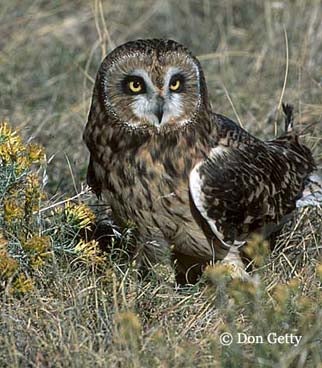SCIENTIFIC NAME:
Asio flammeus (Pontoppidan)
OTHER NAMES:
Bog Owl, Flat-faced Owl, Marsh Owl, Prairie Owl (Terres 1980).
STATUS:
Rare in winter, spring, and fall in Tennessee Valley and Inland Coastal Plain regions. Occasional in Gulf Coast region. HIGH CONSERVATION CONCERN.
DESCRIPTION:
A medium-sized (33-43 cm [13-17 in.]; Terres 1980) owl; females slightly larger than males. General coloration mottled tawny brown and buff above, and whitish to rust below with dense vertical streaking on breast. Head large and round with very small, barely visible “ear” tufts. Wings long; a buffy patch beyond the wrist above, and a dark patch at the base of the primaries below; distinctive black carpal bars and dark wingtips. Yellow eyes contrast with dark facial disk (Tate et al. 1998, Holt and Leasure 1993). Main-tains winter territories and gives a loud eeee-yerp during territorial defense and a high-pitched, rasping wak, wak, wak (like barking of a small dog), or rapid toot-toot-toot-toot-toot on nesting grounds (Terres 1980). Birds from North America classified as Asio f. flammeus, one of eight or nine recognized subspecies (Holt and Leasure 1993).
DISTRIBUTION:
One of world’s most widely distributed owls (Holt and Leasure 1993). In North America, breeding distribution from northern Alaska, northern Yukon, northern Mackenzie, central Keewatin, southern Baffin Island, northern Quebec, northern Labrador, and Newfoundland south to the eastern Aleutian Islands, central California, northern Nevada, northern Utah, northeastern Colorado, Kansas, northwestern Missouri, southern Ontario, and New Brunswick east to western Ontario, western North Dakota, western South Dakota, and western Nebraska (AOU 1998, Sibley 2000). Wintering distribution in North America from southern Canada to southern Baja California, Oaxaca, Puebla, Veracruz, the Gulf Coast, southern Florida, and the Greater Antilles and Cayman Islands (AOU 1998). In Alabama, rare in winter, spring, and fall in the Tennessee Valley and Inland Coastal Plain regions and casual in the Gulf Coast region (Jackson 2001a).
HABITAT:
Breeds in open country, including prairies, meadows, tundra, shrub-steppe, marshes, agricultural areas, and savanna. Also winters primarily in open country, including tall grass, weedy fields, savannas, stubble fields, and shrub thickets (Holt and Leasure 1993, AOU 1998).
LIFE HISTORY AND ECOLOGY:
Seasonal monogamous pair bonds occur between mid-February and June. Elaborate courtship flights performed. Breeding territory sizes may be related to prey density (Holt and Leasure 1993). Nest built on ground, generally in a slight depression, and sparsely lined with grasses, weed stalks, and a few feathers. Nest sites located in open fields or marshes, often at the base of a clump of tall weeds or grasses (Terres 1980). A clutch of four to nine (usually five to six) white eggs laid in March-September (Tate et al. 1998). Female incubates eggs for 21 to 31 days. Young hatch asynchronously and only female broods. Male delivers food to female, who then feeds nestlings. Young fledge about 28-36 days after hatching and can remain dependent on parents for 50 days (Holt and Leasure 1993). When hunting, usually flies low over ground with wings held horizontally or in a slight V. Flight has been described as buoyant and mothlike. Diet consists mainly of small mammals, particularly voles, but also includes mice, shrews, cotton rats, rabbits, pocket gophers, and bats (Terres 1980). Birds also consumed, but generally comprise less than 2 percent of the diet (Holt and Leasure 1993). Roosts on the ground, very often communally in winter, especially in areas of high prey density. Roosts may be shared with northern harriers (Terres 1980).
BASIS FOR STATUS CLASSIFICATION:
Has declined in many regions of North America, especially the northeastern United States, apparently due mostly to loss of habitat from human activities (Holt and Leasure 1993). Hunting habitats must be capable of providing an adequate prey base for wintering and migrating birds, which requires maintenance of early successional stages. Areas of approximately 50 hectares (120 acres) or larger of low, open grasslands or similar habitat with abundant small mammal populations should be considered as potential wintering habitat (Tate et al. 1998). Priority designation in Alabama is based on Partners In Flight (PIF) scores for relative abundance, threats to nonbreeding populations, and winter population trend. Occurs in low relative abundance in all parts of its breeding and wintering distribution. Severe deterioration in the future suitability of nonbreeding conditions is expected in all bird conservation regions that occur in Alabama. Population trend data for wintering short-eared owls indicate a large decrease in all bird conservation regions occurring in Alabama (PIF 2002).
Author:
Paul D. Kittle






